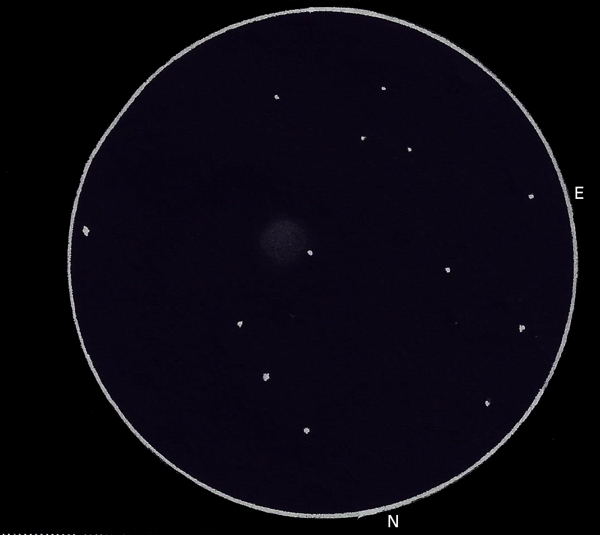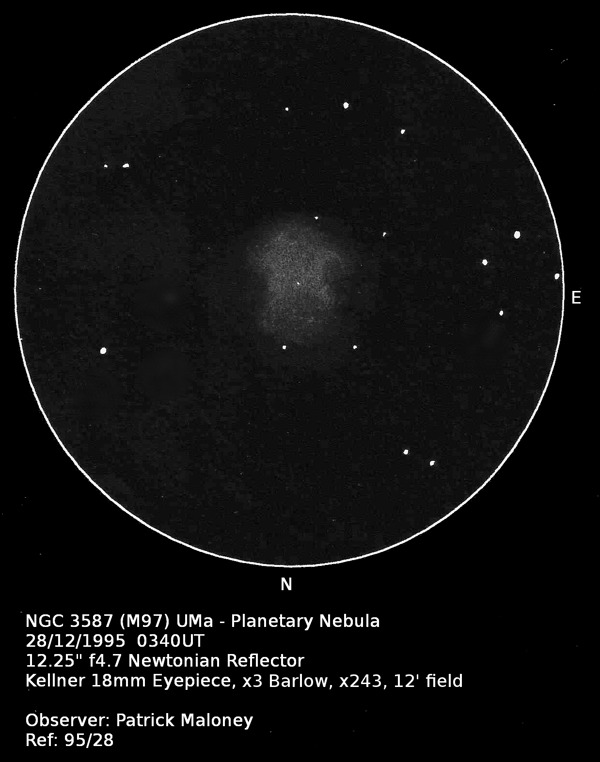Messier 97 in Ursa Major
March 2022 - Nebula and Cluster of the Month
For the same reasons as outlined in last month’s feature, I find myself somewhat bereft of objects to write about for this month.
I’m therefore going to concentrate on a single object, NGC 3857, alternatively known as Messier 97, PK 148+57.1 and PN G 148.4+57.0.

M97 lies in Ursa Major, 2.3° ESE of β Ursae Majoris (Merak), the bottom right-hand star of the bowl of the Plough.
It was first seen by Pierre Méchain on 16 February 1781. His friend Charles Messier then observed it for the first time on 24 March of that year. He wrote of his observation: Nebula in Ursa Major, near beta. “It is difficult to see”, reports M. Méchain, “especially when one illuminates the micrometer wires: its light is faint, without a star.” ... Near this nebula he saw another which has not yet been determined, also a third near gamma Ursae Majoris. Diam 2’.
The two other ‘nebulae’ discovered by Méchain are almost certainly NGC 3556 and NGC 3992. In fact, so secure are these identifications that these two galaxies have now been designated as M108 and M109, even though they never actually made it into Messier’s catalogue.
The Herschels, father and son, both observed the object, William describing it as A globular body of equal light throughout
and John as Diam. 2’40”, light equable, with a softened edge and fairly bi-central.
Lord Rosse observed it with his 72” Leviathan, writing that it was Two stars considerably apart in the central region; dark penumbra around each spiral arrangement.
Kenneth Glyn Jones notes of this observation that on many occasions only one star was seen and the spiral form was doubtful.

The reference to two stars is problematic. There are actually three stars visible in the nebula. One is the central white dwarf, and the others are line-of-sight objects. They are not in the locations shown on Rosse’s charming and somewhat comical illustration. Thomas Romney Robinson, Director of the Armagh Planetarium, and inventor of the four-cup anemometer, observed M97 through Rosse’s telescope in 1848. He describes A most intricate group of spiral arcs disposed round two starry centres, looking like the visage of a monkey.
Our own Rev. T. W. Webb in his Celestial Objects for Common Telescopes, adds something to the story: Large, pale planetary nebula. Very remarkable object: two stars, one in each opening – only one seen since 1850.
Are these just mistaken observations? The ‘voids’ in the planetary nebulae are not centred on stars, as these 19th-century observers would have us believe. It’s easy to misplace a star, especially an extremely faint one, when making an observation. They fade in and out of sight and it can be very difficult to place them directly where they actually lie. The brightest of the three stars in the nebula is the central white dwarf, magnitude 16 (or is it? – see later) and the second brightest is magnitude 17.
M97 is one of the closer planetary nebulae to us, lying about 2000 light-years away. It consists of (at least) three concentric shells of nebular material, and expansion data indicates that it began expanding, at the time of the central star’s collapse into a white dwarf, about 8000 years ago. Its current diameter is a little less than one light-year and it contains 0.13 solar masses of material.
I have made two observations of this object, both reproduced here. Firstly with a 4½” (11cm) reflector in 1979 and then again in 1995 with a 12” (300mm) reflector. The observation made with the smaller telescope was made under dark sky conditions and demonstrates that the planetary is visible in small telescopes if the conditions are right. Kenneth Glyn Jones (KGJ) in Messier’s Nebulae and Star Clusters writes M.97 is a fairly difficult object to find as it is small and faint and will probably elude instruments smaller than 6-inches aperture.
He was observing with an 8” (200mm) reflector, but his observation shows a field of 65’. Higher power is much better for planetary nebulae. The tired old maxim that deep-sky objects demand wide-field low powers is a much-regurgitated myth.
Through my little 4½” ‘scope, I saw ...a large, bright disc of non-homogeneous light. Indistinct dark and light patches appear briefly before disappearing once again into the overall glow. A very noticeable feature of the nebula is the absence of a faint periphery. ... M97 has a very definite edge. A star of about mag 11 is very close Nf.

The central star is widely quoted as having a magnitude of 16 (very specifically in Uranometria as 16.01). In my observation of 1995, I have placed the central star where I saw it. KGJ states that the central star is of magnitude 14. If it was really a 16th mag. object, I doubt I would have seen it. My estimate was about 15, as it was just occasionally glimpsed. I noted the planetary’s large size and brightness. The brightness over the disc was irregular, and darker incursions were seen on both sides of the object.

The Night Sky Observer’s Guide – Volume 2 Spring & Summer states that This planetary’s disk is about the same diameter as Jupiter’s disk...
The diameter of M97 is 194” as opposed to Jupiter’s maximum of about 50”. This jarringly incorrect statement, made almost immediately after the diameter of the object is correctly quoted, had me scratching my head for a while until I came across the description given by Admiral W. H. Smyth in his Cycle of Celestial Objects (1859). He says This very singular object is circular and uniform and after long inspection, looks like a condensed mass of attenuated light seemingly the size of Jupiter.
It seems that this is another astro-myth being repeated without being checked. It just goes to show that even the most highly-regarded texts can sometimes be misleading.
| Object | RA | Dec | Type | Magnitude |
|---|---|---|---|---|
| M97 | 11h 11m 48s | +55° 01’ 09” | Planetary nebula | 9.9v, 12.0p |